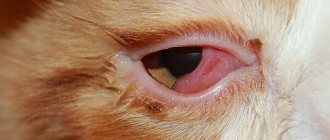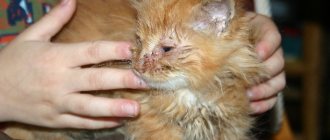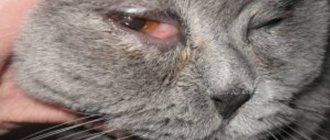Allergist
Bykov
Sergey Anatolyevich
17 years of experience
Allergist (immunologist), Candidate of Medical Sciences, member of the Russian Association of Allergists and Clinical Immunologists, member of the European Academy of Allergology and Clinical Immunology (EAACI).
Make an appointment
Judging by the number of calls to allergists from patients with complaints, we can confidently say that allergies to cats in adults are a common phenomenon.
Many people mistakenly believe that allergies are caused by animal fur. But this opinion is wrong. Wool is a carrier of the allergen, but it itself is safe. The allergen that causes allergies to cats in adults and children is cat protein, traces of which remain on all objects with which the animal has come into contact. Naturally, cat fur is a real “storehouse” of cat protein, which has become the reason for the dissemination of not entirely accurate information about allergies to cat fur, which in fact is not the root cause of this disease.
The cleanliness of cats for allergy sufferers is rather a minus in this case. Cats constantly lick their fur, leaving protein marks on it. This fur then ends up on furniture, walls, floors and clothing. A person prone to allergies to cats comes into contact with this fur even unnoticed, and the result is an allergic reaction of the body. Moreover, with increased sensitivity, a reaction can occur even when communicating with a person whose clothing or skin has traces of cat protein.
Symptoms
Let's look at how allergies to cats manifest themselves. In fact, the manifestations of an allergic reaction can be of different types.
Respiratory symptoms of a cat allergy:
- nasal congestion and allergic rhinitis;
- burning sensation and itching in the throat and nose;
- cough and sneezing;
- dyspnea;
- swelling of the nasopharynx.
Against the background of these symptoms, general weakness and even fever may occur.
The intensity of respiratory symptoms varies from person to person. For some, they appear after prolonged contact with a cat, while for others, an attack can begin literally when the animal appears.
Manifestations of a skin allergic reaction to cats:
- the appearance of irritation and itching on the skin;
- burning and itching;
- rash, blistering and redness.
Skin symptoms usually appear upon direct contact with the animal. If an allergic reaction is expressed only in this way, then it will be enough for the patient to simply minimize the risks of their manifestation - it is enough to exclude contacts with felines.
Allergic manifestations of food nature:
- nausea;
- pain syndrome in the stomach.
If an allergen gets into food, symptoms can manifest themselves in this way - a general deterioration in the condition, the urge to vomit and pain in the stomach. In this case, it is also important not to delay your visit to the doctor, so that the specialist has the opportunity to make the correct diagnosis as early as possible.
Other cat allergy symptoms:
- headache;
- lethargy and irritability;
- the appearance of swelling in the eye area, profuse lacrimation.
It should be noted that all of the listed symptoms are not unique and may indicate the development of another disease. Therefore, the key point is accurate diagnosis and determination of the cause of the symptoms that appear.
Are you experiencing cat allergy symptoms?
Only a doctor can accurately diagnose the disease. Don't delay your consultation - call
Features of pathology in kittens
Kittens of this breed can also be a bit teary. However, these discharges are detected only after the pet wakes up. Normally they almost never happen.
But a veterinarian will definitely be needed when the kitten has a brown or yellow-green tinge to the eye discharge. A specialist should show the animal if the eyelids are swollen or if there is excessive lacrimation.
Provoking factors in small kittens include:
intrauterine infection;- lack of vaccinations;
- congestion of the tear ducts;
- weak immune system.
If a kitten has a little clear discharge after sleep, and its eyes sparkle, then these are not pathological processes.
Diagnostics
Self-diagnosis and starting to take anti-allergy medications is the worst solution. Only professional diagnostics in a clinic can accurately determine the cause of the symptoms. The fact is that allergies are often disguised as many other diseases that can be triggered. Allergies can also pose a serious threat to the human body, leading to swelling of the larynx and other consequences.
The main method for diagnosing cat allergies is special medical tests. The patient's blood is taken for analysis to detect immunoglobulin E, as well as skin tests.
Why is it not recommended to self-medicate? There are many cases where the cat did not cause the symptoms, although in a sense the animal played a role, which allowed false conclusions to be drawn. The most common options for establishing an erroneous diagnosis:
- an allergic reaction can be caused by accessories and animal care products (litter, cat shampoo, cat food, etc.);
- cats accustomed to walking outside can carry other allergens on their fur (pollen, mold particles, etc.);
- infection from an animal with other diseases with similar symptoms (chlamydia, scabies mites, etc.).
Therapy methods
Treatment primarily depends on the underlying cause of your cat's watery eyes. If the phenomenon is provoked by a physiological factor and a peculiarity of the breed, then the pet’s eyes should not be treated.
At home, when the disease develops, the following remedies are used to treat the eyes:
- tetracycline ointment;
- Levomycetin drops;
- Furacilin;
- Sulfacyl sodium;
- Albucid;
- solution of potassium permanganate (weak).
The veterinary pharmacy sells special medications.
The following drugs are considered effective:
- Diamond eyes;
- Phytoelite;
- Iris.
To treat your eyes, you need to wipe them with cotton wool in the direction from the outer to the inner corner. If medications used for 2-3 days are ineffective, the cat needs to be shown to a specialist .
In addition to eye treatment, treatment should be aimed at eliminating the underlying cause that caused this symptom.
If the pathology is caused by worms, anthelmintic drugs are used. Antibacterial agents are used for various infections. Watery eyes caused by allergies are treated with antiallergic medications.
Traditional methods of treatment
What to do if you don’t have any medications on hand, and your cat’s eyes are watering? In this case, traditional therapy recipes are used. These include decoctions of medicinal plants.
Herbs used are:
chamomile;- marigold;
- calendula;
- green tea;
- sage;
- St. John's wort.
They help eliminate crusts containing pus after the cat wakes up, relieve the inflammatory process, and inhibit the growth and reproduction of pathogens.
Treatment
If the diagnosis confirms an allergy to cats, then the patient will have to make several important decisions. Treatment for cat allergies primarily focuses on symptom management, general relief, and prevention. It is impossible to completely eliminate the disease and, as with all types of allergies, the key is to eliminate contact with the allergen. Therefore, if a person suffers from allergies, but cannot imagine his life without a pet, then he will have to adjust his lifestyle and constantly take anti-allergy medications.
Due attention will have to be paid to cleaning the apartment. It should be regular. Be sure to use a powerful vacuum cleaner that will remove hair from carpets and sofas.
There is another affordable option - allergy-free cats. There are also hypoallergenic cat breeds. It cannot be said that the secretion of cat protein in animals of such breeds is completely absent. The allergen is released, but in much smaller quantities. Therefore, depending on the degree of sensitivity in some, it may not cause an allergic reaction at all, while in others its manifestations will be insignificant.
Which cats do not cause severe allergies? These include cats with dense, curly hair, for example, representatives of the Cornish Rex breed. Due to the density of the coat, hair loss occurs less frequently and hair does not spread so much everywhere. But fluffy cats with thick undercoat are definitely not recommended for people with a tendency to allergies. They shed easily, causing the fur to spread throughout the room and accumulate on furnishings. Carpets, bedspreads, rugs, pillows and blankets, soft toys and other objects with a soft surface are especially dangerous from the point of view of the accumulation of cat hair.
A minimum of problems awaits owners of Sphynx cats. And to minimize the impact of the cat's secreted protein, they need to be bathed regularly - on average 1-2 times a week.
Physiology of the breed
British cats and Scottish cats have a lot in common. Their similarity is not limited only to appearance. The muzzle of representatives of these breeds is shortened, as a result of which the functioning of the nasolacrimal ducts, which are responsible for controlling the flow of tears after moistening the cornea, is impaired. The remaining intraocular fluid that accumulates on the conjunctiva splashes out. Both Scots and Britons experience watery eyes most at an early age. However, a cat’s visual organs leak not only due to physiological characteristics. A number of pathologies may also be to blame for this.
Preventive actions
If you want to have a pet, it is recommended to experimentally test the reaction of your body and household members for the presence of allergies. For example, visit acquaintances or friends who already have a cat or cat. It is better if the communication is long and not five minutes, since an allergic reaction may not appear immediately. If after the experiments no signs of allergy were observed, then with a high degree of probability we can talk about its absence.
If you know that you are prone to an allergic reaction, but your love for cats does not allow you to completely give up your pet, then before getting a kitten, you need to carefully choose the breed. Hypoallergenic breeds will make the life of an allergy sufferer much easier.
But what if you already have a cat and are later diagnosed with an allergy? In this case, to reduce allergy symptoms and maintain a normal state, the following preventive measures must be taken:
- minimize direct contact with the animal if possible;
- take special anti-allergenic drugs;
- bathe the animal, and then comb the fur at least once a week (if possible, this should be entrusted to household members who do not suffer from allergies);
- If possible, remove as much as possible carpets, rugs, blankets and other soft coverings that can accumulate wool;
- regularly ventilate the premises;
- Do not leave personal items and items of your wardrobe in a place accessible to the animal.
How to wash the eyes of a Scottish kitten or cat?
Prepare boiled or bottled water at room temperature or a decoction of chamomile, sage, calendula, St. John's wort, tea. The ideal option is saline solution from a pharmacy. Lay or sit the cat so that the eyes are turned upward. It is advisable to do this together: one holds, the other rinses. The task of the one who holds is to make sure that the cat does not twitch. The task of the one who is dripping is to very carefully part the eyelids and pour the liquid collected into the syringe without a needle into the eye. You can use a clean pipette. Once you have washed your eyes, take a moistened cotton pad and wipe your eyes from the outer to the inner corner.
If there is a foreign object in the cat’s eyes that you can’t just wash off, then this is a reason to urgently seek help from a veterinarian.
Article continues after advertisement
Prevention measures
To prevent lacrimation, you must follow the following prevention rules:
- Properly care for your cat.
- Carry out antiparasitic treatment regularly.
- Vaccinate the animal in a timely manner.
Prevent the development of infectious diseases.- Make a complete and rational diet for your cat.
- Strengthen the animal's immune system.
- Make sure that no foreign objects get into your pet's eyesight.
For prevention, you can treat your cat's eyes with chamomile infusion.
Excessive tear production
Too short tear ducts lead to the release of a large volume of fluid from the eyes. The cause of the process can be either natural (for example, morning tears) or artificial.
In the first case, it is enough to remove the crusts that have formed in the corners of the eyes. In the second, we should look for the mechanism that caused the effect of watery eyes in the Scottish Fold cat. It may be based on foreign bodies, short-term aggressive influences (odors), reactions to food components, light and ambient temperature.
Important! If the increased level of tear production goes away quickly, the cause is a short-term episodic irritation of the eye. Otherwise, consultation with a veterinarian-ophthalmologist, diagnosis and prescription of a course of medications are necessary.
Puncture with frontal sinusitis
Without a puncture, you can clear the sinuses and administer medications using a special Yamik catheter. If frontal sinusitis progresses to a severe, protracted stage, a puncture is required. This will clear the sinuses of pus.
In more advanced cases, a trephine puncture operation is required, in which a special tube (cannula) is inserted into the sinus opening. With its help, the sinuses are washed and the necessary antibiotic is administered.
Such surgical interventions are performed under local anesthesia.
In especially severe cases, open surgery is prescribed.
Frontitis: complications and consequences
The chronic stage of frontal sinusitis is dangerous due to its complications. A history of acute respiratory viral infection or a simple cold often causes an exacerbation of the disease, which lasts about three weeks.
When sinusitis passes into the chronic stage, there is a danger of purulent contents of the sinuses penetrating through the back walls into the skull. The consequence of this can be severe purulent meningitis or an abscess.
If a purulent infection penetrates through the thin lower wall of the sinus, the eye sockets will be seriously damaged.
These complications are very dangerous as they can be fatal.
The consequences of untreated frontal sinusitis affect other organs and lead to inflammatory processes in the tonsils, bone tissue and heart muscle tissue, conjunctivitis and damage to the optic nerve, otitis media or pneumonia.











